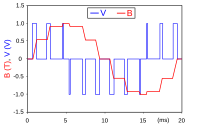
Photo from wikipedia
Abstract. Significance: A majority in the photoacoustic (PA) community unconditionally accepts that pulse PA signals show much higher signal-to-noise ratios (SNRs) than continuously excited PA signals. However, we indicate this… Click to show full abstract
Abstract. Significance: A majority in the photoacoustic (PA) community unconditionally accepts that pulse PA signals show much higher signal-to-noise ratios (SNRs) than continuously excited PA signals. However, we indicate this existing notion would not be valid for very low optical-fluence light-emiting diodes (LEDs)/laser diodes (LDs)-based PA systems. Aim: We demonstrate in theory and simulation that when the optical fluence of PA-excitation waveforms is much lower than the American National Standards Institute (ANSI) maximum permission exposure (MPE), matched filtered PA signals from chirp waveforms show higher SNRs than those of pulse train waveforms. Approach: We theoretically derive the PA SNR expression considering the pulse fluence reduction factor based on the ANSI MPE. We investigate and analyze SNR ratios of the pulse train and chirp-waveform matched filtered PA signals with conceptual understanding. We also perform brute-force simulations to extract PA SNRs for the verification of the result. Results: The brute-force simulations show that the matched filtering with chirp waveforms could achieve better SNRs than pulse train waveforms for very low-fluence PA systems. As the fluence is smaller, the SNR of the matched filtered PA signals is more dominant than that of pulse trains in a wider PA data acquisition time range. In addition, estimated SNR ratios adopting actual parameters of LED/LD-based pulse train PA systems in previous literature support the finding of this paper. Conclusions: The result can extend the possibility of applying various continuous waveform techniques already studied in the conventional radar technology to PA systems of limited optical power, which would diversify and expedite the research and development of LED/LD-based, compact, and cost-effective PA systems.
Journal Title: Journal of Biomedical Optics
Year Published: 2022
Link to full text (if available)
Share on Social Media: Sign Up to like & get
recommendations!